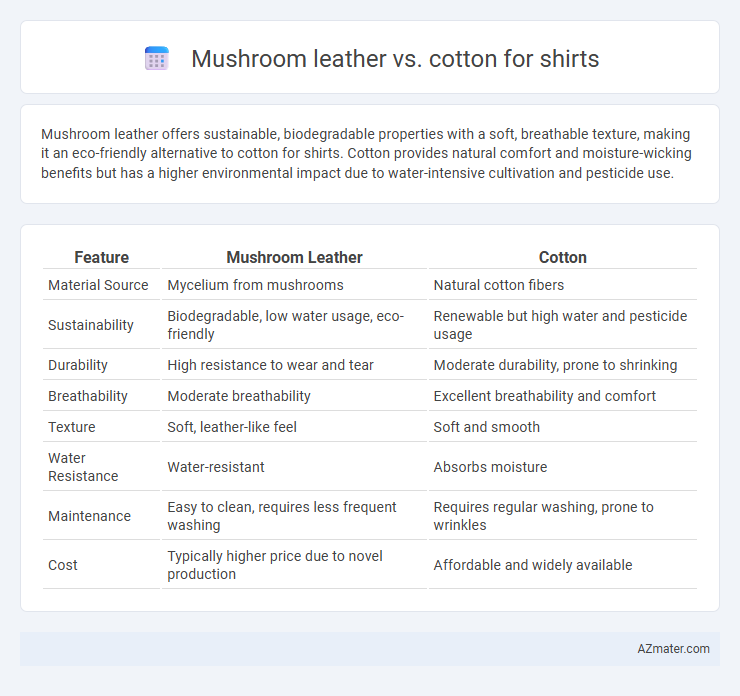Mushroom leather offers sustainable, biodegradable properties with a soft, breathable texture, making it an eco-friendly alternative to cotton for shirts. Cotton provides natural comfort and moisture-wicking benefits but has a higher environmental impact due to water-intensive cultivation and pesticide use.
Table of Comparison
| Feature | Mushroom Leather | Cotton |
|---|---|---|
| Material Source | Mycelium from mushrooms | Natural cotton fibers |
| Sustainability | Biodegradable, low water usage, eco-friendly | Renewable but high water and pesticide usage |
| Durability | High resistance to wear and tear | Moderate durability, prone to shrinking |
| Breathability | Moderate breathability | Excellent breathability and comfort |
| Texture | Soft, leather-like feel | Soft and smooth |
| Water Resistance | Water-resistant | Absorbs moisture |
| Maintenance | Easy to clean, requires less frequent washing | Requires regular washing, prone to wrinkles |
| Cost | Typically higher price due to novel production | Affordable and widely available |
Introduction to Mushroom Leather and Cotton
Mushroom leather, derived from sustainable mycelium growth, offers a biodegradable and eco-friendly alternative to traditional materials, making it increasingly popular in fashion industries. Cotton, a natural fiber obtained from the cotton plant, is widely used for its breathability, softness, and durability in shirt production. Both materials present distinct benefits: mushroom leather excels in sustainability and innovative texture, while cotton remains favored for comfort and moisture absorption.
Material Origins: How Mushroom Leather and Cotton Are Made
Mushroom leather is created from mycelium, the root structure of fungi, harvested and processed through fermentation to form a sustainable, biodegradable material. Cotton is a natural fiber obtained from the seed hairs of the cotton plant, requiring extensive water, pesticide use, and mechanical harvesting during its cultivation. The production of mushroom leather involves innovative biotechnology techniques, whereas cotton relies on traditional agricultural methods with significant environmental impact.
Sustainability Comparison: Environmental Impact
Mushroom leather significantly reduces environmental impact compared to cotton by utilizing mycelium, a fast-growing fungus that requires minimal water, no pesticides, and less land. Cotton cultivation demands substantial water resources, extensive pesticide use, and contributes to soil degradation, leading to higher carbon emissions than mushroom leather production. The biodegradable nature of mushroom leather also limits landfill waste, offering a more sustainable alternative for eco-friendly shirt manufacturing.
Comfort and Wearability of Mushroom Leather vs Cotton
Mushroom leather offers a unique balance of breathability and moisture-wicking properties, providing comfortable wear similar to traditional cotton shirts. Unlike cotton, mushroom leather is naturally hypoallergenic and resistant to bacteria, reducing irritation and odor during extended use. While cotton remains lightweight and soft, mushroom leather's flexibility and durability enhance wearability, especially in sustainable fashion applications.
Durability and Longevity: Which Lasts Longer?
Mushroom leather demonstrates superior durability compared to cotton due to its resistance to wear, water, and mildew, making it ideal for long-lasting shirts. Cotton, while breathable and comfortable, tends to degrade faster with frequent washing and exposure to moisture, affecting its lifespan. Therefore, mushroom leather shirts typically maintain structural integrity and appearance significantly longer than traditional cotton garments.
Aesthetic Appeal: Texture, Look, and Style
Mushroom leather offers a unique, smooth texture with a subtle natural grain that creates a modern, sophisticated look compared to the classic softness and breathability of cotton. Its matte finish and slight sheen provide a stylish, eco-friendly alternative that enhances contemporary fashion with an artisanal edge. Cotton shirts maintain timeless versatility with their naturally crisp yet soft texture, allowing for a wide range of styles from casual to formal.
Maintenance and Care Tips for Both Fabrics
Mushroom leather requires gentle cleaning with a damp cloth and should be kept away from direct sunlight to prevent cracking, while cotton shirts benefit from regular machine washing and can tolerate higher temperatures. Avoid harsh chemicals or bleaching agents on mushroom leather to maintain its durability, whereas cotton can handle most detergents but may shrink if washed in hot water. Proper storage for both includes keeping them in a cool, dry place to extend fabric longevity and maintain appearance.
Cost Analysis: Pricing and Affordability
Mushroom leather, derived from mycelium, generally carries higher production costs compared to traditional cotton, influenced by its innovative manufacturing process and limited scalability. Cotton shirts benefit from established, large-scale agricultural and textile industries, resulting in lower and more stable prices for consumers. The premium price of mushroom leather garments may limit affordability, positioning them as niche, sustainable fashion items rather than mass-market apparel.
Market Availability and Consumer Choices
Mushroom leather, an innovative sustainable material derived from mycelium, is rapidly gaining market availability but remains limited compared to the widespread presence of traditional cotton fabric in shirt production. Consumer choices currently favor cotton due to its familiarity, softness, and affordability, although increasing environmental concerns are driving a niche market shift toward mushroom leather for eco-conscious buyers. Market trends indicate mushroom leather's potential growth in fashion segments focused on sustainability, while cotton maintains dominance due to established supply chains and broad accessibility.
Future Trends: Innovations in Shirt Materials
Mushroom leather, derived from mycelium, offers a sustainable and biodegradable alternative to traditional cotton in shirt manufacturing, which aligns with the growing demand for eco-friendly textiles. Innovations in mushroom leather production focus on enhancing durability, breathability, and moisture-wicking properties to rival the comfort and versatility of cotton shirts. Future trends highlight the integration of bioengineered materials like mushroom leather to reduce water usage and carbon footprint, setting a new standard for sustainable fashion in shirt design.

Infographic: Mushroom leather vs Cotton for Shirt
 azmater.com
azmater.com